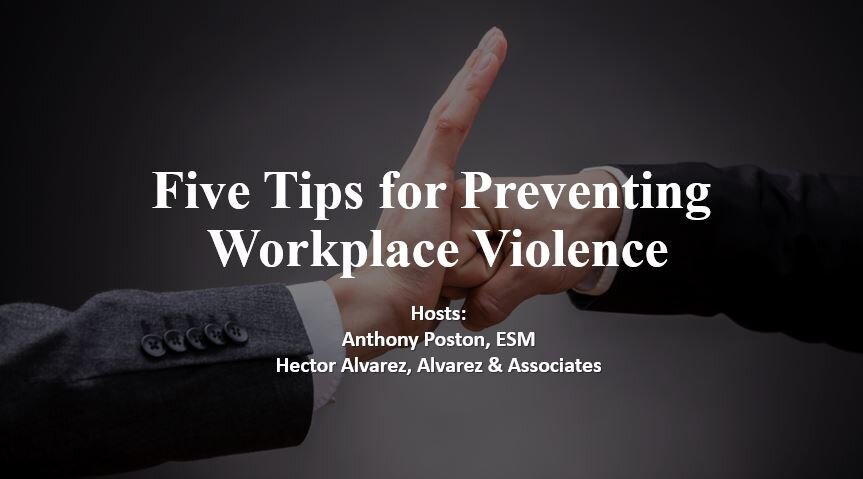Preventing Violence in Our Workplaces
“It’s complicated; keep it simple”
Recently, there seems to be an almost palpable and growing concern of violence occurring in our communities, schools and workplaces. At the same time there is a confusing dynamic. The issue of workplace violence seems to dominate our news feeds (and interest) in a very predictable manner; for a few days, or weeks after a high-profile incident occurs, then the energy fades. However, in the background more and more organizations are working to better understand how to prevent an incident from occurring. This is refreshing to hear as based on a recent Society for Human Resource Management (SHRM) survey of their members more than 50% of HR practitioners were not even sure if their company had a workplace violence prevention program.
The current legislative landscape
Cal/OSHA recently established a violence prevention standard for healthcare, Title 8 CCR 3342 and is now actively working on a general industry standard, Title 8 CCR 3343. While there is no specific timeline for the general industry standard to be adopted, it would be prudent to anticipate that this high-profile issue will move forward without much delay. In other words, it’s time to start getting ready from a compliance perspective.
The Dynamics of Workplace Violence
Much more important than addressing compliance concerns is the reality that violence, even the threat of violence, can and does have a catastrophic impact on the workplace. Understanding how workplace violence occurs is an important first step towards prevention. At the most basic level, three elements must exist simultaneously; a person of concern, our staff and the environment allows for interaction.
Protect the Environment – “Think like a criminal.” What would be attractive for a “bad guy” to take or do at your workplace? Do you deal with cash, do your employees work late at night by themselves, does your work generate significant frustration in clients and customers? Once you identify the threats, the next steps would be to review your vulnerabilities, is it easy to get into the building? Are there obvious hiding spots? Have you adequately trained your employees? Next take steps to mitigate these concerns. Lights, landscaping and locks are the cornerstone of security. The lights around your building should cover the main areas where people are coming and going. Landscaping should be trimmed to help eliminate hiding spots. A recognized standard is nothing taller than 3ft or lower than 8ft. And lastly, the locks on your doors should work AND be used. Can your staff lock the main doors from the inside? Do they have a place inside the office they can retreat to if something bad happens?
Protect your Staff - Strive to create a culture that encourages and supports a very low tolerance for unacceptable behavior. A clearly defined and supported workplace violence prevention policy should be a baseline for setting the correct tone. Staff should be taught to recognize the warnings signs and behavioral indicators of potential violence; these items should be listed in your policy. There are four distinct categories of violence:
Type 1 – Criminal Activity - Includes violence committed by a person who has no legitimate business at the work site and includes violent acts by anyone who enters the workplace with the intent to commit a crime.
Type 2 - Customers/Clients - Includes violence directed at employees by customers, clients, patients, students, inmates, or any others for whom services are provided.
Type 3 - Coworkers- Includes violence against an employee by a present or former employee, supervisor, or manager
Type 4 – Personal Relationships Includes violence committed in the workplace by someone who does not work there but has or is known to have had a personal relationship with an employee.
INSITE users, click on the image or log in to watch the webcast, Five Tips for Preventing Workplace Violence, featuring Hector Alvarez (CEO of Alvarez & Associates) & Anthony Poston (CEO of ESM).
At the most basic level, concerning behavior and actions will be inconsistent with the types of behavior that you want demonstrated in your work environment. Empowering staff by teaching them to recognize inappropriate behavior, providing appropriate reporting resources and options, and then supporting them when they bring concerns forward. Your staff should never allow themselves to become comfortable being uncomfortable.
Evaluate Threats – If and when inappropriate or concerning behavior is brought to your attention it’s imperative that you have a structured process to evaluate the seriousness and credibility of the issue and then determine a course of intervention. While still a relatively new concept, Behavioral Threat Assessment has been recognized as the “missing puzzle piece” needed to help prevent violence. The Association of Threat Assessment Professionals is at the forefront of efforts to provide structured guidance and education on conducting threat assessments. One of the most consistently repeated recommendations is to establish a Threat Assessment Team. Evaluating threats and determining a course of action is a high-risk activity that shouldn’t be undertaken alone; leverage the collective resources and knowledge of a multidisciplinary team. Establishing a formal, team-based approach will help provide structure, strength and more importantly protection vs. an approach that relies on any one person’s opinion.
In summary, keep it simple. Preventing workplace violence is a serious issue, but there are a lot of other serious workplace issues that you must deal with on a daily basis and yet you manage to provide a happy, safe and productive workplace for your employees. Don’t try to do this by yourself, preventing workplace violence should be a team effort. There is no single person that is responsible for keeping the workplace safe, we each have our roles to play. Many organizations find that it’s easier and more effective to establish a small committee to help keep the traction going. Lastly, keep this one sobering reality in mind. In every single workplace violence incident that I’ve reviewed or investigated, there were more often than not very clear warning signs and concerning behavioral patterns that were overlooked, ignored or misunderstood. Strive to create an environment that does not tolerate unacceptable behavior.
About the Author: Mr. Hector Alvarez is a security expert with over 25 years of experience. He specializes in workplace violence prevention and is a Certified Threat Manager™ by the Association of Threat Assessment Professionals. He holds a MS in Forensic Psychology and a BS in Criminal Justice. He has a broad background as a practitioner serving as Security Director protecting one of our nation's most sensitive critical infrastructures, to working as a city police officer and as a professional security consultant. He understands the challenges individuals and organizations face when addressing the threats of violence because he has responded to them. He has personally assessed and/or responded to thousands of potentially violent situations, developed numerous violence prevention programs and trained tens of thousands of employees and managers in the areas of crisis intervention, active shooter response, violence prevention, domestic terrorism and emergency management. You can find out more information about Mr. Alvarez at www.wvpexperts.com




